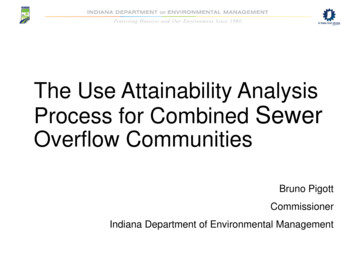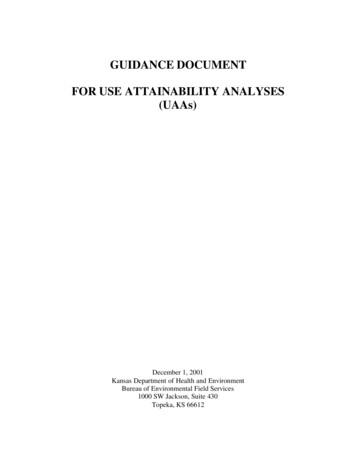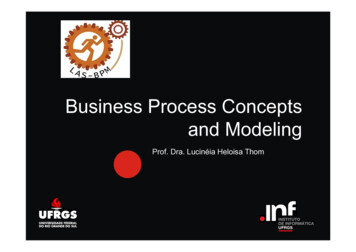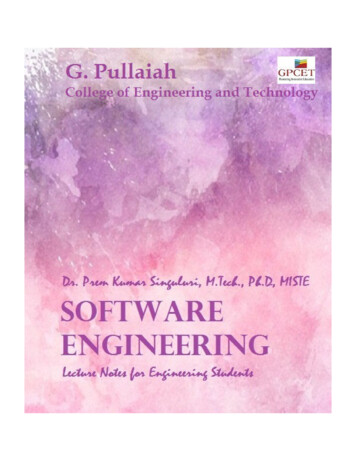
Transcription
The Use Attainability AnalysisProcess for Combined SewerOverflow CommunitiesBruno PigottCommissionerIndiana Department of Environmental Management
Combined Sewer OverflowProgram 109 Communities in Indiana have a Combined Sewer System These systems convey sanitary wastewater and storm waterthrough a single pipe system to a wastewater treatmentplant These systems discharge raw sewage directly to rivers whenrainfall occurs
Combined Sewer OverflowProgram Communities are required to create and implement a planto dramatically reduce discharge of raw sewage IDEM reviews and approves plans The plans entail significant infrastructure improvements andcosts and often take up to 20 years to fully implement Indianapolis alone, for example, will spend over 2 billionon infrastructure improvements
Combined Sewer OverflowProgram All Communities are under enforceable requirements tocomplete their plans. 10 Communities are under federal consent decrees 99 Communities are under state enforceable requirements 53 Communities have completed their work Others are in the process of implementing their plans At the end of the implementation process, mostcommunities will likely have residual discharges fromcombined sewers during periods of high rainfall.
CSO Policy Goals Meet Water Quality Standards (WQS) to protectdesignated uses such as fishing and swimming When WQS cannot be met, reduce the frequency andduration of CSO impacts to the maximum extentachievable without causing serious, adverse social andeconomic impacts on the CSO communities The federal Clean Water Act anticipated these residualevents and allows for a change in the designated useunder certain circumstances
Water Quality Standards Revision The review of designated uses and WQS is called a UseAttainability Analysis (UAA) A UAA is a structured scientific assessment of the factorsaffecting a waterbody’s attainment of its designated use A UAA must be performed to explain why the designatedrecreational use is not attainable Any change in the designated use is a change to the WQS,which is a change to Indiana’s WQS rules The UAA process is spelled out in Federal regulation
Federal UAA RegulationsUnder 40 CFR 131.10(g) States may remove a designateduse which is not an existing use, as defined in § 131.3, orestablish sub-categories of a use if the State candemonstrate that attaining the designated use is notfeasible utilizing, at a minimum, one of the followingfactors
The Six UAA Factors40 CFR 131.10(g)1. Naturally occurring pollutant concentrations prevent the attainmentof the use; or2. Natural, ephemeral, intermittent or low flow conditions or waterlevels prevent the attainment of the use, unless these conditionsmay be compensated for by the discharge of sufficient volume ofeffluent discharges without violating State water conservationrequirements to enable uses to be met; or3. Human caused conditions or sources of pollution prevent theattainment of the use and cannot be remedied or would causemore environmental damage to correct than to leave in place; or
The Six UAA Factors4.5.6.Dams, diversions or other types of hydrologicmodifications preclude the attainment of the use, and it isnot feasible to restore the water body to its originalcondition or to operate such modification in a way thatwould result in the attainment of the use; orPhysical conditions related to the natural features of thewater body, such as the lack of a proper substrate, cover,flow, depth, pools, riffles, and the like, unrelated to waterquality, preclude attainment of aquatic life protection uses;orControls more stringent than those required by sections301(b) and 306 of the Act would result in substantial andwidespread economic and social impact.
UAA Development Collaborative process involving IDEM, the CSO community, EPA andother stakeholders The UAA is complete when it provides adequate documentation of:o No existing use within CSO impacted waterso Demonstrates that the attainment of the designated use is notfeasible due to any of the six identified factorso The extent and duration of the CSO impacts to impacted watersafter the LTCP is implemented
What other designated use is therefor a CSO community’s impactedwaterbodies?CSO Wet Weather Limited Use Subcategory
CSO Wet Weather Limited UseSubcategory This subcategory is set out in Indiana rules and statutes(IC 13-18-3) This subcategory is available only to CSO communities Allows for the suspension of the full body emersion designateduse for a period of time not to exceed four days after the date theoverflow discharge ends Applies to a specific reach of all CSO impacted waterbodies afterimplementation of the LTCP and approved UAA
Rulemaking for CSO Wet WeatherLimited Use Subcategory If the UAA meets the requirements of IC 13-18-3-2.5, it is approvedby IDEM A rule is developed by the Agency for submittal and approval by theEnvironmental Rules Board per IC 13-14-9-14o The new rule will identify CSO impacted waterbodies and theduration for which the CSO wet weather limited use subcategoryis applicable The proposed new rule is submitted to EPA for review and approval
Summary Communities throughout Indiana are implementing plans to dramaticallyreduce raw sewage discharges to waters when it rains IDEM reviews, approves, and tracks implementation of these plans After full implementation, many of these communities will still experienceresidual discharges during high rain events about four times a year The federal clean water act anticipated these residual overflows and allowsfor a change in designated uses under certain circumstances. The process requires communities to submit a Use Attainability Analysis andrequires IDEM to review it and propose rules to the Environmental RulesBoard IDEM anticipates as many as 24 communities could request a change in thedesignated use. IDEM will likely propose a rule for Indianapolis before the end of thecalendar year.
Questions?Bruno gov
If the UAA meets the requirements of IC 13-18-3-2.5, it is approved by IDEM A rule is developed by the Agency for submittal and approval by the Environmental Rules Board per IC 13-14-9-14 o The new rule will identify CSO impacted waterbodies and the duration for which the CSO wet weather limited use subcategory is applicable










